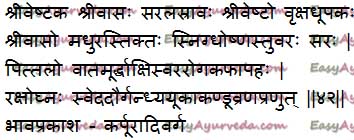Gandhabiroja Uses, Dose, Remedies, Side Effects
By Dr Renita D’Souza
The oleo-resin extract from Sarala tree (Pinus longifolia) is called Gandhabiroj. Oleoresins are the natural extract from plants with oil and resins in combination. The oil extracted from Gandhabiroj is called Turpentine oil.
The oleo-resin extract from Sarala tree (Pinus longifolia) is called Gandabiroj. Oleoresins are the natural extract from plants with oil and resins in combination. The oil extracted from Gandabiroj is called Turpentine oil.
Sarala Tree
Latin name – Pinus longifolia Roxb., Syn. Pinus roxburghii
Family – Pinaceae, Sarala Kula
Table of Contents
Qualities, uses
Medicinal Qualities Of Gandhaphiroja
Rasa (Taste) – Madhura (sweet), Tikta (bitter), Kashaya (astringent)
Virya (Potency) – Ushna (hot)
Guna (quality) – Snigdha (unctous)
Karma (action) – Sara
Action on Tridoshas
Pittala – Increase pitta dosha
Balances vata and Kapha dosha
Indications Of Gandabiroja
Murda roga – head related diseases
Akshi roga – Eye related diseases
Swara roga – voice related problems
Rakshogna – useful to ward of ill psychological effects
Sweda – Excess sweating
Dhourgandya – relieves foul smell
Yuka – lice
Kandu – Itching
Vrana – heals wounds
Skin diseases.
Usage of Purified Gandhabiroj
It is used internally and for external application.
Classical categorisation
Bhavaprakasha – Karpuradi varga
Part of Sarala tree used for medicinal Purpose
Stem powder, Oil, Bark, resin
Read – Sarala – Qualities, Health Benefits,Medicines and Research
How to procure Gandhabiroj?
Ganda biroza is the secretion obtained from the sapwood of Chir pine tree (sarala). A thick, smooth and odoriferous secretion gets collected over the surface of the tree naturally or by a small cut over the surface. The fresh secretion will be white and semisolid which later becomes very thick and dark yellow in colour.
Purification, Dose
Purification of gandh biroja:
Ganda biroja should be purified before its internal usage for health benefits. For purification it is put over the cloth which is tied over the vessel containing equal quantity of milk and water. On heating this vessel gandabiroj melts and through the cloth it gets collected in the vessel. This is collected and dried.
Dose of Gandha phiroj
Niryasa- 1-2 gram
Turpentine oil uses
Turpentine oil is a volatile essential oil extracted from oleo-resin of pine (gandhabiroja).
Crude oleoresin (gandha biroj) is evaporated by steam distillation and these vapours are collected which is further boiled to obtain colourless and clear oil. This collected oil is called turpentine oil. The remnant obtained after oil extraction is called resin.
Synthetic camphor is manufactured from turpentine oil.
Read – Essential Oils Benefits, Usage, Side Effects, Types, Advantages
Features of Turpentine oil
Color – Colourless
Odour – odorous
Taste – sweet, pungent and slight bitter
Indications of turpentine oil
- Kapha disorders
- Muscle pain or cramps
- Worm infestation
- Bloating
- Bronchitis
- Lung congestion
- Wounds
- Swelling
Health Benefits of Turpentine oil
- Normalises the movement of vata (vatanulomaka) hence it is used to relieve abdominal bloating.
- When inhaled it liquefies kapha in the chest and helps to expel it out thus relieving lung congestion. It acts as expectorant.
- For respiratory ailments it can be given along with liquorice or honey.
- To relieve worm infestation enema with turpentine oil and soap water is given.
- Induces sweating.
- Few drops of turpentine oil can be applied with other pain relieving oils to relieve arthritic pain.
- Increases the volume of urine.
- In cut wounds it stops superficial bleeding by constricting the blood capillaries.
Effect of turpentine oil on Tridoshas
Balances kapha and vata dosha
How Turpentine oil is Used?
It is used for inhalation, local application and oral intake.
Dose of Turpentine oil
1 to 3 drops
Sanskrit verse

Side effects, medicines
Side Effects of Turpentine oil
Avoid its excess use as inhaler, local applicant or oral intake.
It can cause skin irritation and sometimes blisters if rubbed hard over the skin or applied over large area of skin.
High oral dosage can cause gastro intestinal irritation, painful micturition, diarrhoea, drowsiness, fainting etc
Avoid its usage in pregnancy or lactation. Keep out of reach and sight of children
Ayurvedic medicines with Gandhabiroja
Chukkumthippalyadi Gulika – It is used in chronic fever
Ayurvedic medicine with turpentine oil
Arlin Liniment – Its is used effectively in rheumatoid arthritis.
Panchgun Tail – It is an Ayurvedic herbal oil used in the treatment of rheumatoid arthritis, ear ache, non healing wounds, etc.
Bestlin Liniment – It is used as muscle relaxant in joint pains, backache, shoulder pain etc.
Rhuma Oil – It is used in cervical and lumbar diseases, relieves arthritic pain.
Jointcare Oil – It is used in arthritis, back ache and musculo-skelatal disorders.
Interaction with medicines, supplements
Can this be used while taking Homeopathic medicine?
Yes. This product does not react with homeopathic medicine.
Can
this medicine be continued while taking supplements like multivitamin tablets,
Omega 3 fatty acids etc?
Yes. Generally, this product goes well with most
of the dietary supplements. However, if you are taking more than one product
per day, please consult your doctor for an opinion.
With western
medicines
Seek your
doctor’s advice if you are taking this product along with other western
(allopathic / modern) medicines. Some Ayurvedic herbs can interact with modern
medicine.
If both Ayurvedic and allopathic medicines are advised together, then it is
best to take Allopathic medicine first, wait for 30 minutes and then take the
Ayurvedic medicine.
Vernacular names
Sanskrit Names Of Gandhbiroja (oleoresin of pine)
Srivaasa, Sarala sraava, Srivesta, Vrekshadhupaka
Vernacular Names of Oleoresin of pine
Hindi Name – Gandabiroja, Saral ka gound, biroja
Kannada Name – Srivestaka
Tamil Name – pinaimaaru
Gujrati Name – Berajo
Marati Name – Saraladik
English Name – Oleo-resin of pine (Pinus longifolia)
Click to Consult Dr Renita D’Souza










